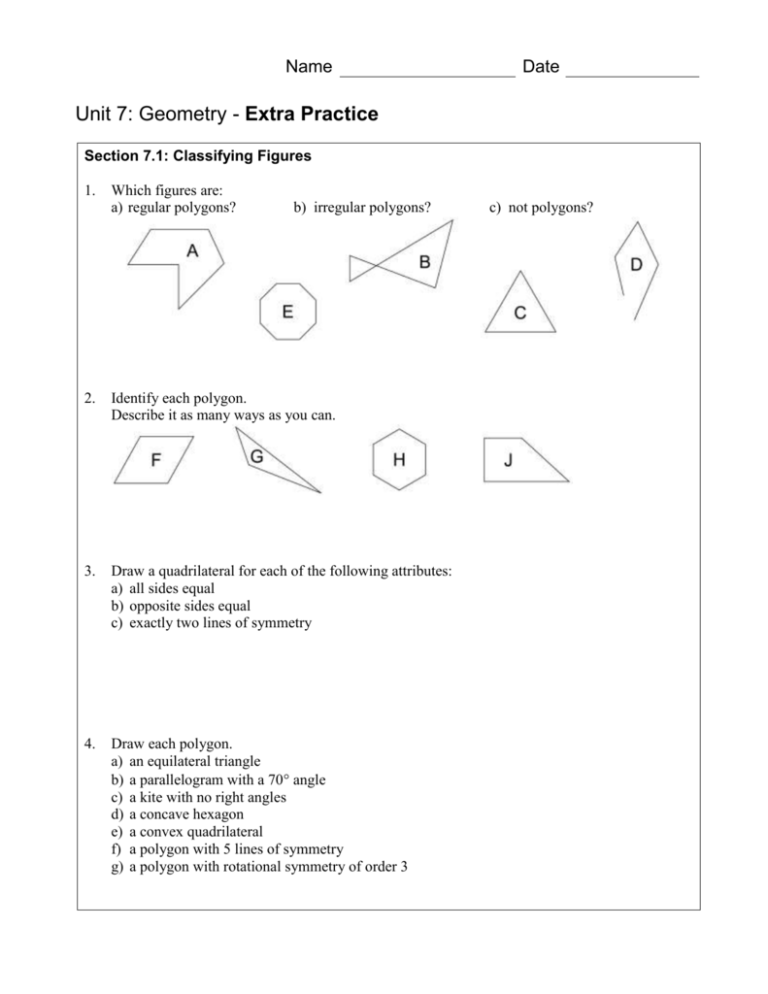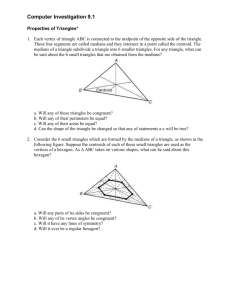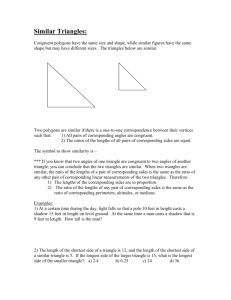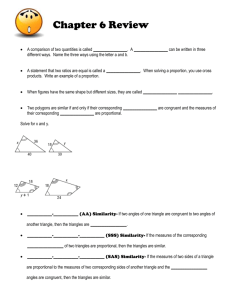Extra Practice Unit 7 - Geometry
advertisement

Name Date Unit 7: Geometry - Extra Practice Section 7.1: Classifying Figures 1. Which figures are: a) regular polygons? b) irregular polygons? 2. Identify each polygon. Describe it as many ways as you can. 3. Draw a quadrilateral for each of the following attributes: a) all sides equal b) opposite sides equal c) exactly two lines of symmetry 4. Draw each polygon. a) an equilateral triangle b) a parallelogram with a 70 angle c) a kite with no right angles d) a concave hexagon e) a convex quadrilateral f) a polygon with 5 lines of symmetry g) a polygon with rotational symmetry of order 3 c) not polygons? Section 7.2: Congruent Figures 1. Look at the triangles below. Find pairs of congruent triangles. Explain why they are congruent. 2. An isosceles triangle has a side of length 8 cm and an angle of 40°. How many triangles can you draw that are not congruent to one another? 3. ∆PQR and ∆KLM have QR = LM = 8 cm, and angle PQR = angle KLM = 50°. a) Sketch the triangles. b) What else do you need to know to tell if the triangles are congruent? 4. a) Draw two triangles with corresponding angles equal, but the triangles are not congruent. b) Draw two triangles with 2 angles equal and 1 side equal, but the triangles are not congruent. c) Draw two triangles with 2 sides equal and 1 angle equal, but the triangles are not congruent. 5. a) Are all quadrilaterals with 4 pairs of corresponding sides equal congruent? Explain. b) Are all quadrilaterals with 4 pairs of corresponding angles equal congruent? Explain. c) What do we need to know for two quadrilaterals to be congruent? 81 Section 7.3: Transformations You will need grid paper and tracing paper. 1. Use the figures to the right. Identify the transformation for which: a) Figure A is the image of Figure X. b) Figure B is the image of Figure X. c) Figure C is the image of Figure X. d) Figure D is the image of Figure X. 2. Draw the figure on a coordinate grid. The coordinates are A(5, 6), B(6, 7), C(8, 7), and D(8, 5). Draw the image of the figure after each transformation. a) a translation 6 units right and 2 units down b) a reflection in a vertical line through (11, 0) 1 c) a rotation of a 4 turn clockwise about point D d) a reflection in a horizontal line through (0, 4) 1 e) a rotation of a 2 turn about point A 3. Write two ways that Figure B can be described as a transformation of Figure A for each diagram. 4. a) Which pairs of congruent figures represent a figure and its transformation image? Describe the transformations. b) Which pair of congruent figures does not represent a figure and its transformation image? Section 7.4: Tiling Patterns 1. Use dot paper. Draw a non-symmetrical quadrilateral on dot paper. Show how it can be used to tile the plane. 2. Copy each figure on grid paper. Show one way each figure can be used to tile the plane. 3. a) Use dot paper. Draw a hexagon that will tile the plane. Show part of the tiling. Explain how it tiles the plane. b) Draw a hexagon that will not tile the plane. Show how it does not tile the plane. Explain why the hexagon does not tile the plane. Which figures will fill the gaps? 4. Use dot paper or grid paper. Draw a polygon with exactly one line of symmetry. Can it be used to tile the plane? Explain using diagrams and words. 83 Section 7.5: Using Transformations to Make Designs 1. Start with the shaded square. Use transformations to describe how to create squares A, B, C, and D. Start with the shaded rectangle. Use transformations to describe how to create rectangles F and G. 2. Start with the shaded figure. Use transformations to describe how to create figures A, B, C, and D. 3. Use grid paper or dot paper. Use a trapezoid and a rhombus to make a design. Use transformations to describe the design. Sample Answers Extra Practice 1 – Master 7.20 Extra Practice 2 – Master 7.20 Section 7.1 Section 7.2 1. a) Figure C and Figure E are regular polygons because they have all sides equal and all angles equal. b) Figure A is an irregular polygon because all sides are not equal and all angles are not equal. c) Figure D is not a polygon because it is not a closed figure. Figure B is not a polygon because more than two sides meet at a vertex. 2. Figure F is a rhombus. It has 4 sides, all sides equal, 2 pairs of parallel sides, opposite angles equal, 2 acute angles, 2 obtuse angles, and 2 lines of symmetry. Figure G is an obtuse scalene triangle. It has 3 sides, no sides equal, no angles equal, 2 acute angles, 1 obtuse angle, and no lines of symmetry. Figure H is a regular hexagon. It has 6 sides, all sides equal, all angles equal, and each angle measures 120. It has 6 lines of symmetry and rotational symmetry of order 6. Figure J is a right trapezoid. It has 4 sides, 1 pair of parallel sides, 2 right angles, 1 acute angle, and 1 obtuse angle. 3. a) b) 1. Triangle A and triangle D are congruent because corresponding sides are equal. Triangle B and triangle G are congruent because 2 pairs of corresponding sides and the angle between them are equal. Triangle C and triangle H are congruent because 2 pairs of corresponding angles and the side between them are equal. 2. 3. a) b) The lengths of PQ and KL or the measures of R and M are needed. 4. a) c) b) 4. a) b) c) c) d) 5. a) No, pairs of corresponding angles may not be the same. b) No, pairs of corresponding sides may not be the same. c) We need to know that 4 pairs of corresponding sides and 4 pairs of corresponding angles are equal. Extra Practice 3 – Master 7.22 e) f) Section 7.3 1. a) Figure X is rotated a 1 turn clockwise about turn 4 centre c. b) Figure X is reflected in mirror line l. g) c) Figure X is rotated a 1 turn about turn centre d. 2 d) Figure X is translated 10 units right and 4 units down. 85 b) The hexagon does not cover the page. It leaves gaps that are rhombuses. There are points where vertices meet and the sum of the angles is less than 360. So, the hexagon does not tile the plane. 2. 3. a) A rotation of a 1 turn about the common vertex; 2 a reflection in the horizontal line through the common vertex b) A reflection in the vertical line midway between the two figures; a rotation of a 3 turn clockwise about the 4 point 4 units right and 1 unit up from the upper vertex of Figure A c) A translation of 8 units right; a rotation of a 1 turn 2 about a point midway between the two figures 4. a) Figure A is reflected in a vertical line through the point (4, 7) to get Figure B. 1 Figure E is rotated a turn clockwise about the point 4 (9, 2) to get Figure F. Figure G is translated 3 units right and 2 units up to get Figure H. b) Figures C and D: it takes more than one transformation to get Figure C to Figure D. Extra Practice 4 – Master 7.23 4. I chose an isosceles triangle. It has one line of symmetry. The triangle can be used to tile the plane. Congruent copies of the triangle cover the page and leave no gaps. At any point where vertices meet, the angles add to 360. A triangle always tiles the plane. Extra Practice 5 – Master 7.24 Section 7.5 1. Reflect the shaded square in its right side to get square A. Translate the shaded square 4 units right and 3 units up to get square B. Translate the shaded square 8 units right and 3 units up to get square C. Reflect the shaded square in a vertical line through the midpoint of the bottom side of square B to get square D. Reflect the shaded rectangle in a horizontal line through the centre of the square above it to get rectangle F. Translate the shaded rectangle 8 units right and 3 units down to get rectangle G. 2. The shaded figure is translated 6 units right to get Figure D. 1 turn about the vertex 2 Section 7.4 The shaded figure is rotated a 1. common to Figure B and the shaded figure to get Figure B. The shaded figure is rotated a 1 turn counterclockwise 4 about the vertex common to Figure B and the shaded figure to get Figure A. The shaded figure is rotated a 2. a) b) 1 turn 4 counterclockwise about its upper right vertex to get Figure C. 3. c) 3. a) The hexagon tiles the plane because it tiles the page and leaves no gaps. At any point where vertices meet, the angles add to 360. 81 The shaded trapezoid is reflected in its right side to get trapezoid A. The shaded trapezoid is reflected in its bottom side to get trapezoid B. Trapezoid B is reflected in its right side to get trapezoid C. The 4 trapezoids form a hexagon. The hexagon is translated down 4 units to get trapezoids D, E, F, and G. The shaded rhombus is rotated a 1 turn about 2 its bottom vertex to get rhombus H. Rhombus H is reflected in a horizontal line through its bottom vertex to get rhombus J. The entire section of trapezoids and rhombuses is translated 8 units right to get the second column. Continue translating to cover the page.







